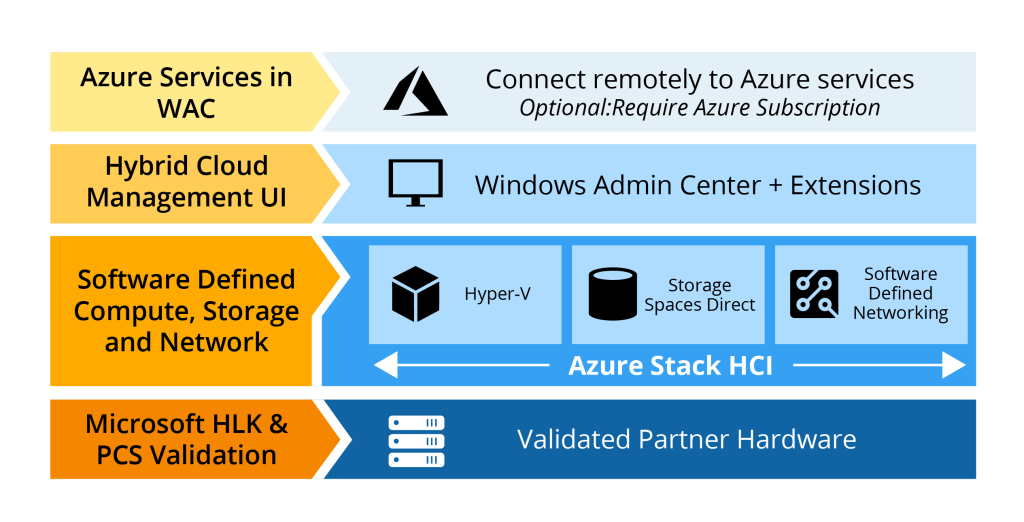Azure Stack Portfolio: HCI, Hub, and Edge Solutions for Hybrid Cloud
The ever-evolving IT landscape demands flexible solutions that bridge on-premises infrastructure with the power of the cloud. Microsoft’s Azure Stack portfolio delivers just that, offering a range of products tailored to your specific hybrid and edge computing needs. This blog post dives into the functionalities, use cases, and implementation considerations of Azure Stack HCI, Azure Stack Hub, and Azure Stack Edge, along with a brief history of the Windows Server Software Definition (WSSD) program that laid the groundwork for these innovative solutions.
A Legacy of Innovation: The WSSD Program
Before exploring the Azure Stack family, let’s rewind to the Windows Server Software Definition (WSSD) program. Launched in 2016, WSSD aimed to simplify on-premises deployments by offering pre-configured software stacks optimized for specific workloads. This program paved the way for the modular and adaptable approach that characterizes the Azure Stack portfolio.
Azure Stack HCI: Hyperconverged Powerhouse

Azure Stack HCI is a hyperconverged infrastructure (HCI) solution that seamlessly integrates compute, storage, and networking resources into a single, software-defined cluster. This powerhouse caters to organizations seeking to:
- Modernize their datacenters: Azure Stack HCI offers a scalable and cost-effective way to refresh virtualization infrastructure by leveraging a hybrid approach with built-in Azure integration.
- Consolidate workloads: Run both virtualized and containerized workloads efficiently, streamlining management and optimizing resource utilization.
- Empower remote offices: Deliver robust infrastructure for branch locations with simplified deployment and management capabilities.
- Support demanding workloads: Azure Stack HCI handles high-performance workloads with ease, making it ideal for data analytics, virtual desktops, and other resource-intensive applications.
Considerations for Azure Stack HCI Implementation:
- Existing infrastructure: Assess compatibility with Azure Stack HCI’s hardware and software requirements.
- Workload needs: Identify the workloads you plan to migrate or deploy to ensure optimal performance.
- Management expertise: In-house IT teams should possess the necessary skills for deployment and ongoing management.
Azure Stack Hub: Your On-Premises Azure Cloud
Azure Stack Hub brings the power of Azure services directly to your datacenter, enabling you to build, deploy, and manage hybrid applications in a familiar Azure environment. This solution is ideal for organizations with:
- Strict data residency requirements: Azure Stack Hub allows you to keep sensitive data on-premises while still benefiting from Azure’s development and management tools.
- Limited or unreliable internet connectivity: Deploy and run applications locally without relying on a constant internet connection.
- Hybrid application needs: Azure Stack Hub bridges the gap between on-premises and cloud-based resources, fostering seamless application development and deployment.
Considerations for Azure Stack Hub Implementation:
- Security expertise: A strong understanding of security best practices is crucial for managing an on-premises cloud environment.
- Resource allocation: Carefully plan resource allocation to ensure sufficient capacity for your intended workloads.
- Ongoing management: Dedicate resources for ongoing management tasks like patching and updates.
Azure Stack Edge: Intelligence at the Edge
Azure Stack Edge extends Azure intelligence to the edge of your network, enabling local data processing, analytics, and filtering. This solution is perfect for scenarios involving:
- Limited bandwidth: Process and analyze data locally before sending it to the cloud, reducing bandwidth consumption.
- Disconnected environments: Ensure continuous operations in remote locations with limited or no internet connectivity.
- Real-time decision making: Perform real-time data analysis at the edge, enabling faster and more informed decision-making.
Considerations for Azure Stack Edge Implementation:
- Network connectivity: Evaluate network bandwidth and latency to determine if local processing is necessary.
- Data security: Implement robust security measures to protect sensitive data processed at the edge.
- Device management: Establish a plan for ongoing device management and updates.
Conclusion
The Azure Stack portfolio empowers organizations to harness the power of hybrid and edge computing. By understanding the functionalities, use cases, and implementation considerations of Azure Stack HCI, Hub, and Edge, you can make informed decisions about the right solution for your specific needs. As cloud adoption continues to rise, these innovative offerings provide a future-proof approach to managing your IT infrastructure.
